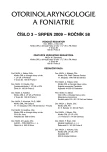16th April: World Voice Day
Authors:
J. G. Švec 1,2; F. Šram 2; J. Vydrová 2
Authors‘ workplace:
Oddělení biofyziky, Katedra experimentální fyziky PřF UP, Olomouc
1; Hlasové centrum Praha
2
Published in:
Otorinolaryngol Foniatr, 58, 2009, No. 3, pp. 152-155.
Category:
Comprehensive Reports
Overview
World Voice Day was first organized in 2003 and since then it is celebrated annually on April 16. The aim of the event is to increase public awareness of the importance of voice for human communication and for quality of life, and improve alertness to voice problems. On this day societies, institutes and groups dedicated to voice care organize various public events, such as media interviews, open days, voice screenings, laryngeal examinations, public performances and so on. Voice can and should be used as an early indicator of laryngeal disorder. When hoarseness lasts longer than three weeks, people should be encouraged to visit a specialist (phoniatrician or laryngologist) who can examine their larynx for the cause of the hoarseness. Such attentiveness to voice problems could help detecting laryngeal cancers or other pathologies at an early stage when they can be treated with a minimal harm to the organism. World Voice Day provides an opportunity to convey these messages to the public and improve the state of public knowledge on human voice.
Key words:
World Voice Day, voice, voice disorders, interdisciplinarity, science and art.
Sources
1. Andrea, M.: World Voice Day. Personal notes, unpublished, 2007.
2. Awan, S. N., Morrow, D. L.: Videostroboscopic characteristics of young ydult female smokers vs. nonsmokers. J. Voice, 21, 2007, s. 211-223.
3. Behlau, M., Hogikyan, N. D., Gasparini, G.: Quality of life and voice: Study of a Brazilian population using the voice-related quality of life measure. Folia Phoniatr. Logop., 59, 2007, s. 286-296.
4. Benninger, M. S., Ahuja, A. S., Gardner, G., Grywalski, C.: Assessing outcomes for dysphonic patients. J. Voice, 12, 1998, s. 540-550.
5. Branski, R., Sivasankar, M.: An update on voice research in the United States. ASHA Leader, 11, 2006, s. 10-11.
6. Crevier-Buchman, L.: Research and treatment related to voice in France. ASHA Leader, 11, 2006, s. 28-29.
7. Davies, J., Anderson, S., Huchison, L., Stewar, G.: Interactions between voice clinics and singing teachers: A report on the British Voice Association questionnaire to voice clinics in the UK. Logoped Phoniatr Vocol, 32, 2007, s. 83-86.
8. Gray, S. D., Titze, I. R., Lusk, R. P.: Electron microscopy of hyperphonated canine vocal cords. J. Voice, 1987, 1, s. 109-115.
9. Gray, S. D.: Pignatari, S. S., Gardiny, P.: Morphologic ultrastructure of anchoring fibers in normal vocal fold basement membrane zone. J. Voice, 8, 1994, s. 48-52.
10. Horáček, J., Švec, J.: Modelování lidského hlasu: Využití v klinické praxi i při zpěvu. Vesmír, 87, 2008, s. 833-835.
11. Krischke, S., Weigelt, S., Hoppe, U., Kellner, V., Klotz, M., Eysholdt, U., Rosanowski, F.: Quality of life in dysphonic patients. J. Voice, 19, 2005, s. 132-137.
12. Lamprecht, J., Bless, D., Hess, M. M.: Nasal and laryngeal mucosa as an important target area for contact with enviromental noxious agents. In: Wotte J. et al. (eds.), Enviromental engineering and pollution prevention. Kluwer Academic Publisher, 1996, s. 431-441.
13. Lamprecht, J., Hess, M.: Das Strömungsverhalten von Fluiden und die regionale Ablagerung von Aerosolpartikeln im menschlichen Larynxmodell. Otolaryngol Nova, 3, 1993, s. 128-134.
14. Murry, T., Rosen, C. A.: Phonotrauma associated with crying. J. Voice, 14, 2000, s. 575-580.
15. Preciado-Lopez, J., Perez-Fernandez, C., Calzada-Uriondo, M., Preciado-Ruiz, P.: Epidemiological study of voice disorders among teaching professionals of La Rioja, Spain. J. Voice, 22, 2008, s. 489-508.
16. Ruben, R. J.: Redefining the survival of the fittest: communication disorders in the 21st century. Laryngoskope, 110, 2000, s. 241-245.
17. Sataloff, R. T.: World Voice Day. Ear Nose Throat. J., 84, 2005, s. 123.
18. Smith, E, Verdolini, K, Gray, S. D., Nichols, S., Lemke, J., Barkmeier, J., Dove, H., Hoffman, H.: Effect of voice disorders on quality of life. J. Med. Speech-Lang. Pathol., 1996, 4, s. 223-244.
19. Speak out! New talk about voice.World Voice Day, April 16, 2003. American Academy of Otolaryngology - Head and Neck Surgery Bulletin, 22, 2003, 3.
20. Šram, F., Švec, J., Havlík, R., Frič, M.: Poruchy hlasu. Iatrike Techne, 2003, 1, LVI-LXII.
21. Švec, J. G., Behlau, M.: April 16th: The World Voice Day. Folia Phoniatr. Logop., 59, 2007, s. 53-54.
22. Švec, J. G., Šram, F.: Voice research and treatment in the Czech Republic. ASHA Leader, 11, 2006, s. 30-31.
23. Švec, J. G.: World Voice Day. Logoped Phoniatr Vocol,, 33, 2008, s. 2.
24. Taking care of your voice. NIDCD Fact Sheet. 2002. Bethesda, M. D., National Institute of Deafness and Other Communication Disorders.
25. Trigg, D. J., Lait, M., Wenig, B. L.: Influence of tobacco and alcohol on the stage of laryngeal cancer at diagnosis. Laryngoskope, 110, 2000, s. 408-411.
26. Verdolini, K., Ramig, L. O.: Review: Occupational risks for voice problems. Logoped. Phoniatr. Vocol, 26, 2001, s. 37-46.
27. Wilson, J. A., Dary, I. J., Miller, A., MacKenzie, K.: The quality of life impact of dysphonia. Clin. Otolaryngol, 27, 2002, s. 179-182.
28. World Voice Day. Acta Otorhinolaryngol Belg., 57, 2003, s. 99-100.
29. World Voice Day. American Academy of Otolaryngology - Head and Neck Surgery (http://www.entnet.org/VoiceDay), 2003.
30. Zraick, R. I., Risner, B. Y., Smith-Olinde, L., Gregg, B. A., Johnson, F. L., McWeeny, E. K.: Patient versus partner perception of voice handicap. J. Voice, 21, 2007, s. 485-494.
Labels
Audiology Paediatric ENT ENT (Otorhinolaryngology)Article was published in
Otorhinolaryngology and Phoniatrics

2009 Issue 3
Most read in this issue
- Uvulopalatopharyngoplasty Combined with Radiofrequency Thermotherapy of Tongue Base in the Therapy of Obstructive Sleep Apnea Syndrome
- Czech Version of the Voice Handicap Index Questionnaire for Quantitative Evaluation of Voice Problems Perceived by Patients
- Pyoderma Gangrenosum as a Sign of Extraintestinal Manifestation of Crohn Disease in ENT Region
- Long-term Results of the Sentinel Lymph Node Biopsy in Patients with Oral Cavity Carcinoma
